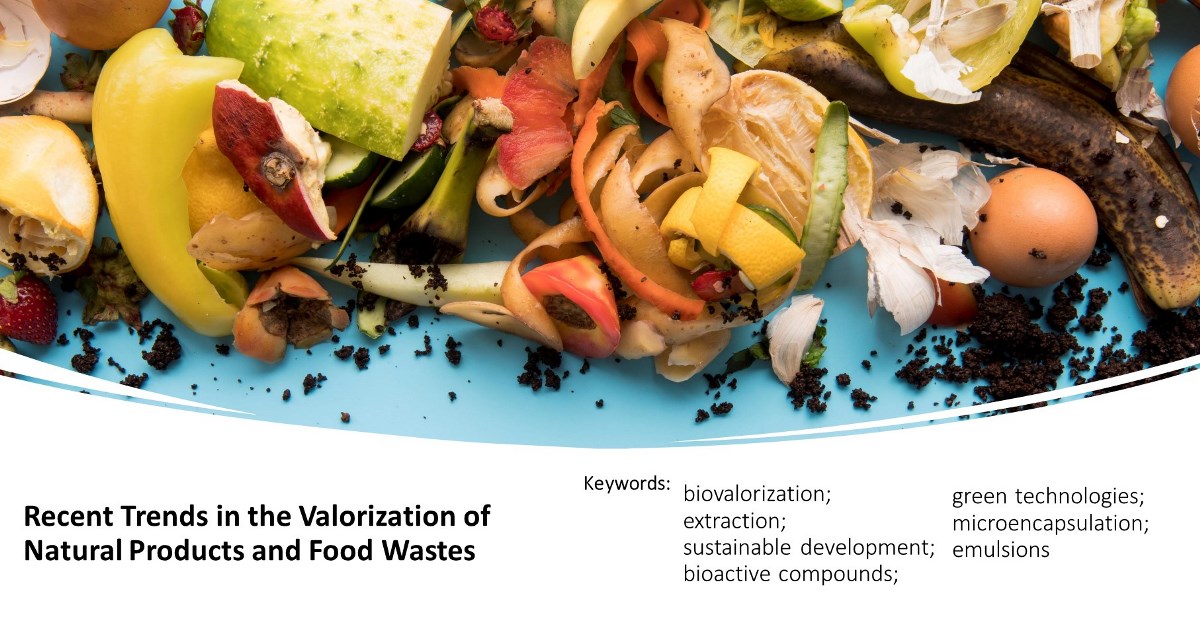- 2.5Impact Factor
- 5.5CiteScore
- 20 daysTime to First Decision
Recent Trends in the Valorization of Natural Products and Food Wastes
This special issue belongs to the section “Food Science and Technology“.
Special Issue Information
Dear Colleagues,
This Special Issue of Applied Sciences, entitled “Recent Trends in the Valorization of Natural Products and Food Wastes”, invites the submission of original research and review articles focused on innovative approaches to the sustainable exploitation of natural resources and agro-industrial by-products.
With growing global concerns regarding environmental sustainability, food security, and waste reduction, the valorization of natural products and food wastes has emerged as a key research area. This Special Issue aims to highlight recent advances in the extraction, transformation, and application of bioactive compounds and other high-value ingredients derived from natural matrices and food residues. Contributions that explore novel bioprocesses, green extraction technologies, or the development of value-added products—such as functional foods, nutraceuticals, bioplastics, or natural additives—are particularly welcome.
Emphasis will be given to strategies that contribute to the circular economy and address challenges related to waste minimization, resource efficiency, and industrial scalability. Studies involving interdisciplinary methodologies, biorefinery concepts, or collaborations between academia and industry are also encouraged.
Topics of interest include (but are not limited to) the following: (i) advanced extraction and purification techniques for natural products, (ii) utilization of food wastes as sources of bioactive compounds or biomaterials, (iii) green chemistry and environmentally friendly valorization strategies, (iv) development of functional ingredients and sustainable product formulations, and (v) technological and economic assessments of valorization pathways.
We look forward to receiving your valuable contributions to this Special Issue.
Dr. Andreia Ribeiro
Dr. Maria Filomena Barreiro
Guest Editors
Manuscript Submission Information
Manuscripts should be submitted online at www.mdpi.com by registering and logging in to this website. Once you are registered, click here to go to the submission form. Manuscripts can be submitted until the deadline. All submissions that pass pre-check are peer-reviewed. Accepted papers will be published continuously in the journal (as soon as accepted) and will be listed together on the special issue website. Research articles, review articles as well as short communications are invited. For planned papers, a title and short abstract (about 250 words) can be sent to the Editorial Office for assessment.
Submitted manuscripts should not have been published previously, nor be under consideration for publication elsewhere (except conference proceedings papers). All manuscripts are thoroughly refereed through a single-blind peer-review process. A guide for authors and other relevant information for submission of manuscripts is available on the Instructions for Authors page. Applied Sciences is an international peer-reviewed open access semimonthly journal published by MDPI.
Please visit the Instructions for Authors page before submitting a manuscript. The Article Processing Charge (APC) for publication in this open access journal is 2400 CHF (Swiss Francs). Submitted papers should be well formatted and use good English. Authors may use MDPI's English editing service prior to publication or during author revisions.
Keywords
- biovalorization
- extraction
- sustainable development
- bioactive compounds
- green technologies
- microencapsulation
- emulsions

Benefits of Publishing in a Special Issue
- Ease of navigation: Grouping papers by topic helps scholars navigate broad scope journals more efficiently.
- Greater discoverability: Special Issues support the reach and impact of scientific research. Articles in Special Issues are more discoverable and cited more frequently.
- Expansion of research network: Special Issues facilitate connections among authors, fostering scientific collaborations.
- External promotion: Articles in Special Issues are often promoted through the journal's social media, increasing their visibility.
- e-Book format: Special Issues with more than 10 articles can be published as dedicated e-books, ensuring wide and rapid dissemination.

